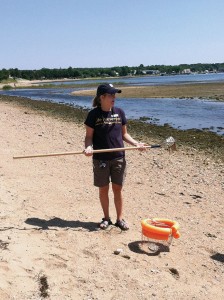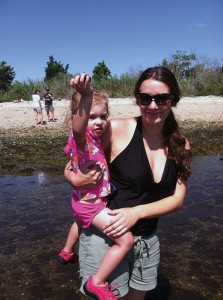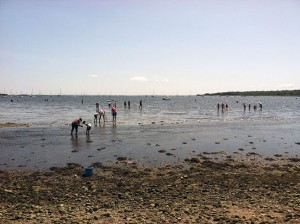Last Saturday was beautiful – hot and sunny with a slight breeze blowing a few lazy clouds through the sky. It was the perfect beach day, or, for those feeling a little more adventurous, the perfect day to learn to quahog.
The Buzzards Bay Coalition provided this opportunity to learn all about the basics of quahogging to locals for free through its Bay Adventures series.
Late Saturday morning, on August 9, participants were invited to the Mattapoisett Beach at Camp Massasoit for a Quahogging 101.
Of the roughly 30 people who arrived, only a couple had experience quahogging. Still, as one elderly participant happily pointed out, “You’re never too old to learn something new.” Likewise, the Coalition representatives were happy to teach.
“Quahogging in general is just something that embraces the culture of Buzzards Bay,” said Meghan Gahm, an outdoor educator from the Buzzards Bay Coalition. “It tends to give a motivation to help protect the bay and keep it clean as well, which is one of the things that we promote at the Buzzards Bay Coalition.”
Gahm began Saturday’s event by explaining a quahog’s habitat and the tools used to fish for them. These shellfish bury themselves just below the sand, allowing one to dig for them using a small rake. The shellfish rakes often have baskets attached to them, making it easier to filter the quahogs out of the sand.
“An hour before and after low tide is when it’s the best to go out there,” said Gahm.
Gahm added that the day’s fishing would be a “dig and release” event, unless participants had a Mattapoisett shellfish permit. Each town has separate regulations, locations, and permits for shellfishing.
According to the Mattapoisett website, a shellfish permit for a Mattapoisett resident is just $25. For a Marion or Rochester resident, the cost to shellfish in Mattapoisett is $35. For all other non-residents, the cost is $135. These permits are valid for one year, except for senior citizens who receive a gold permit button that remains valid for the lifetime of the owner.
Gahm explained that Mattapoisett has four locations open to shellfishing, each specifically marked on maps available on the Town’s website. Those with a permit may fish in these locations, filling up to one peck basket of quahogs per week.
This is how the town prevents overfishing, discussed Buzzards Bay Coalition restoration ecologist Sara de Silva Quintal later on. They only allow a certain number of permits per year, and they limit the amount of fishing per permit. This, plus the monitoring of commercial fishing, lets the town create an estimate of the bay’s quahog population. With this information, they may close certain areas to shellfishing to allow for restoration. The town may also close an area if it is polluted, as the pollutants can infect the shellfish and make a person sick.
Thus, the regulations look out for the health of both land and bay residents. To aid the quahog population, the size of the quahogs allowed to be taken is regulated. Those with a permit to shellfish must have a gauge – a metal rectangle with a one-inch by two-inch rectangle cut out in the center. If the quahog fits through the center rectangle, it is too small to be taken and must be released. Quahogs take about three years to get to the proper size for shellfishing, but they can live up to 40 years.
After all information was relayed and questions were answered, the quahogging tools were passed out. The Buzzards Bay Coalition provided rakes, water shoes, and a couple peck baskets to those participating. Everyone headed into the water, eager to put their new knowledge to use. While some waded up to their waist in the low tide, those with young kids preferred to stay close to shore, discovering crabs and oysters along with some small quahogs.
“If they’re smiling that’s all we really care about,” laughed Gahm, speaking of the kids participating. “For them to just get out with their families and do something different, be in the water, be aware of the area that’s around them.”
This is not the Coalition’s first successful quahogging event; they started having these events in 2012 and continue them due to the great response they receive.
“We had a lot of interest for this program,” said Gahm. “We probably had around 100 inquiries for it, which is great. People want to get out there and learn to quahog, so we’ll hopefully be having many of these in the future.”
The Coalition has more Bay Adventures planned before the summer ends, including a trip to Penikese Island. More information on the Coalition and these events can be found at www.savebuzzardsbay.org/BayAdventures.
By Renae Reints


